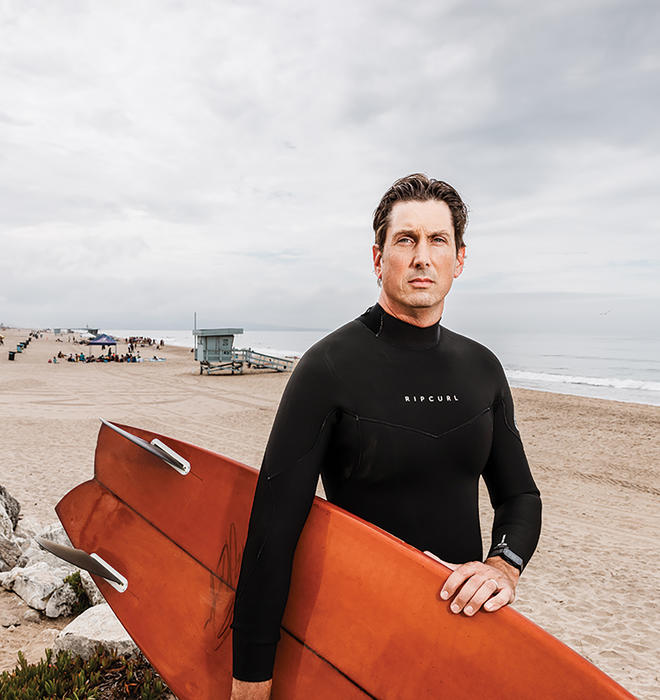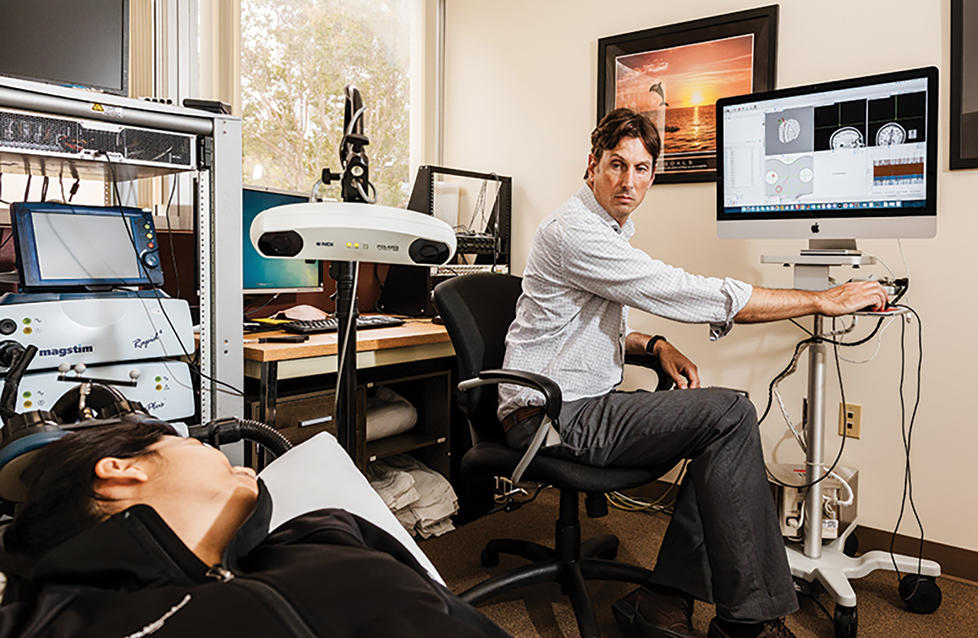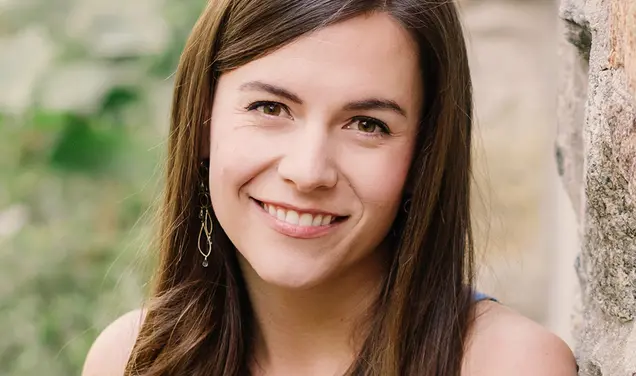
Surfing to Take Away the Suffering
Jason Kutch ’01 is studying the neuroscience of chronic pain and finding new ways to manage his own condition
The first wave Jason Kutch ’01 ever caught on a surfboard still fixes in his mind: a magical feeling of flying, disbelief, and pride. It was a bit of an out-of-body experience, where he could see himself from above. “There’s just all these emotions that go into it,” he says. “And then you get off of that first wave and there’s no other thought that goes into your head other than to go back out and do it again. You get this rush of chemicals happening in your brain.”
The power of surfing to shift focus from the internal world to the external has changed Kutch’s life. In his 20s, as a scientist studying the brain, he was stricken with a debilitating pain condition. His search for relief led him to a new scientific understanding of how pain shows up in the brain. Meanwhile, it was surfing that helped him find relief — and a potential therapy for others. Now, he’s embarking on a study to understand the mechanisms of surfing.
Kutch, now 45, stood at the shore in the early summer, watching the surfers at Topanga Beach in Los Angeles County. He settled into a meditated state, focusing on the magic moment between waves, when he thinks about what surfing means to him. He doesn’t need to catch the best wave of the day. “I just like being out there,” he says. “There’s like the sweet spot where even one halfway-decent wave will make this brain mechanism click. And then you get the benefits, and the rest of the day is great.”
Kutch is an associate professor in the University of Southern California Division of Biokinesiology and Physical Therapy and a specialist in how pain influences and is influenced by the brain. As a mechanical engineering major at Princeton, he was interested in finding out how the brain controls movement. He met Darice Wong ’01, a neighbor in Patton Hall and fellow engineering student. She didn’t know him well when she attended a concert with some friends during her junior year and spotted Kutch singing in the opera class. “He’s a super-tall guy and very noticeable,” she says. She was struck by his singing in the role of Papageno — not at all what she imagined he’d be like.
Kutch and Wong, who eventually married, both studied at the University of Michigan — him in applied and interdisciplinary math, her in biomedical engineering. Then they both got postdoctoral research positions in Los Angeles.
As Kutch was finishing his doctoral work at Michigan, he started experiencing chronic pain, beginning as a migraine, then moving to his low back and groin. Since chronic pain diagnoses are based on symptoms rather than tests, Kutch was able to get reasonable diagnoses, but the suggested treatments didn’t help him feel better. The pain affected every part of his life and was isolating because not many young people talk about chronic pain. Kutch remembers getting on a plane and being unable to imagine that anyone else was feeling what he felt. “They would all be screaming if they felt even part of this, even though I knew that wasn’t true and people live with all sorts of really bad pain,” he says. Yet he sat there, not screaming. At least not on the outside.
“It’s very unusual for a scientist, and it really creates this beautiful synergy between his work and the intimate knowledge that he has about being a chronic pain patient.”
— Andrew Schrepf
Professor at the University of Michigan
Kutch was able to keep working, but it was difficult to think about anything other than the discomfort, so his work had to change. He previously had no interest in pain or neuroimaging, but suddenly it was all he could think about. When he ate, slept, walked, or worked in the lab, he felt a constant burning sensation in his groin, a grinding pain that would never turn off.
Pain has been discussed and thought about for all of human history, but it wasn’t until the 1960s that the field of medicine even considered pain worthy of intense study. Even more recently, scientists have just begun to study the mechanisms of pain in a way that doesn’t have to do with the stories we tell ourselves. The opioid crisis has also brought a new energy to studying pain.
Traditionally, it was hard to study overlapping pain conditions, which impact millions of people, according to research published in The Journal of Pain. “The medical establishment generally says, ‘Go to this silo for your headache, go to this silo for your pelvic pain, this silo for your low back pain,’” says Andrew Schrepf, a professor at the University of Michigan who has collaborated with Kutch. “And so, we just missed that kind of phenotype, which is people who’ve got multiple forms of pain.”
There are very few treatments for chronic overlapping pain — the most common being those that target the central nervous system and may include medications such as tricyclic antidepressants, selective serotonin-norepinephrine reuptake inhibitors (SNRIs), anticonvulsants, and muscle relaxants. But none of the drugs work well, Schrepf says.
Kutch began to study “centralized pain,” which is a term used by the scientific community to describe how the central nervous system, including the brain, can amplify pain signals — one of the biggest topics in pain research. In one study, he asked patients with chronic pelvic pain to fill out body maps to assess where they felt pain. A pattern emerged: Many patients had widespread pain across their bodies — from their heads to their shoulders to their low back. Brain scans showed an increase in functional connectivity involving sensorimotor and insular cortices. In short, he found a signature of widespread pain in the brain.
Schrepf says scientists had some sense that while each pain condition had unique components, there was a lot of overlap. “Jason was basically showing in a really elegant way that there were common elements of pain amplification,” Schrepf says. “And that paper is just really, really cool and gave us a lot of ammunition for taking this idea further, that we really should be focused on common mechanisms.”
As someone who has experienced chronic pain, Kutch also has an intuition about pain conditions, Schrepf says, and it’s not a way of thinking that’s available to other researchers in the field. Sometimes he sees Kutch stop in a conversation about research as if he’s checking his own experiences against what he’s thinking scientifically.
“It gives him an insight both into the kinds of questions we should be asking, and also I think it gives him a sense of just compassion that’s not always present in this work,” he says. “It’s very unusual for a scientist, and it really creates this beautiful synergy between his work and the intimate knowledge that he has about being a chronic pain patient.”
Surfing was never meant to be a therapy, until Kutch found the waves. Living in Southern California, the aesthetics of a new lifestyle just made sense to him. He first bought a motorbike, then noticed that someone had a surfboard on their motorbike, so he got an attachment for a surfboard and a board from Costco and drove directly to the beach. He got tossed around over and over as he tried to manage his body and board in the water near Santa Monica. Eventually, he discovered that to learn how to surf, he needed good waves. And he found a spot with a consistently good swell, where he applied his steady scientific study of surfing.
He quickly discovered that it was a way to hack his pain: After he surfed, his pain was lessened for several days. It felt like a cheat code — a trick he could return to over and over, as long as the waves and the board were there.
Soon Kutch was surfing regularly at Topanga Beach and getting to know the surf community. His brain constantly swelled with science. Initially skeptical about studying surfing in the lab, he started to read about the proliferation of surf therapy programs for conditions like PTSD and autism. It made him wonder: Could surfing help people with pain?
Back in his laboratory at USC, Kutch pointed to a noninvasive brain stimulation device called a transcranial magnetic stimulation machine. It delivers a brief pulse of magnetic energy to a targeted spot on someone’s head. The machine is currently approved for the treatment of clinical depression, but he’s studying how it could be used for chronic pain conditions, to help the brain change the way it senses pain. “It feels like a flick on the top of your skull,” he says.
Kutch’s lab is focused on studying chronic overlapping pain conditions, which are believed to come from centralized pain phenomena. “This is one of the most impactful forms of chronic pain because it’s really challenging to treat and these conditions generally start when a person is in their teens, 20s, or 30s,” he explains — just as his pain did.
His lab’s work has shown that patients with chronic overlapping pain conditions have greater “tangling” in the brain between their body representation and their pain network — the signature in their brain.
Chelsea Kaplan, a researcher at the University of Michigan who collaborates with Kutch, scanned the brains of 300 participants, ages 9 and 10. Some of them went on to develop chronic pain conditions within a year, and Kaplan was able to illustrate that there was increased activity and connectivity in the brain regions that Kutch had shown were altered in adults who have had widespread pain for decades. Since this tangling in the brain showed up several months before the subjects started reporting pain, it might be possible to design an intervention or even just offer advice about slowing the progression of the condition. In the future, a headband may be able to do two things: scan an individual’s neural signature of pain-related dysfunction, and stimulate a targeted area of the brain to address his or her pain profile.
In one study currently underway in Kutch’s lab, researchers scanned nearly 500 adults on various days across three years, capturing their level of pain through self-assessment and neural scans. “By analyzing that person’s brain over these multiple time points, we’re able to map out almost an individualized signature of pain,” he says, “which is cool because it gives a really objective measure to the subjective experience of pain.”
It’s not clear why some people develop pain. It could be genetic sensory sensitivity compounded by stress or a spark at the wrong moment, like a sports injury that lights a fire to drive a person into persistent chronic pain. Or it could be the result of repeated exposure to pain that changes the way the brain operates.
What is clear is that once the pain matrix in the brain activates, it’s hard to rewire. If exposed to a pain-provoking stimulus, the brain will activate in several areas such as the insula, which is a part of the cortex and the temporal lobe, says Kutch. But in chronic pain, it’s believed that the sensory motor cortex — the representation of your body — entangles with the pain network in a new way that activates more easily and without a strong stimulus. “They can activate even at a small provocation,” he says. “And so probably at the end of the day, there’s changes in the brain that are altering someone’s overall profile of sensory sensitivity.”
This tangling might make it harder for a person with centralized pain to direct attention away from their body to the outside world, Kutch explains. And that’s where surfing might also be a way to get at the same problem.
Kutch had daydreamed about studying surfing as a treatment for chronic pain, and now he has a pilot grant from USC to team up with two other professors for a year to try to figure out what exactly it is about surfing that seems to offer relief. Is it the immersive environment — the wind, the waves? Or is it the movement on the board, that supernatural feeling of flying on top of a wave?
He’s now able to study those questions. A virtual reality surfing prototype is up and running in Kutch’s lab at USC and undergoing testing. Virtual surfers can paddle around a beautiful tropical island with white sand and palm trees, explore shipwrecks, and get a workout all while needing to stay externally focused that a wave might suddenly come that they would need to be prepared for. A surfboard-like platform that the surfer stands on moves continuously to mimic what the surfer is seeing, which helps to avoid motion sickness, while a fan creates wind to help complete the illusion. The hope is that devices like this can help expand access to similar immersive opportunities to help people with pain even if they don’t live near the ocean.
“By analyzing that person’s brain over these multiple time points, we’re able to map out almost an individualized signature of pain, which is cool because it gives a reallycobjective measure to the subjective experience of pain.”
— Jason Kutch ’01
The initial tests have shown surfing sessions can reliably cut pain in half on average, and in many cases much more. Kutch says brain activity recordings at the beach show evidence that surfing shifts brain activity waves in what is considered to be a positive direction associated with more relaxed states. Longer term studies can help figure out if other people have the same experience that Kutch did — namely that once he learned that surfing was able to reduce his pain, the pain was no longer so threatening, and maybe that helped the pain start to fade away.
“Jason is a unique individual,” says Emeran Mayer, a neuroscientist and gastroenterologist at UCLA who has worked with Kutch on other research. “He’s a superb scientist, an excellent writer, and someone who can excite younger investigators and students.”
When Wong first heard about his ideas, she immediately understood. “I think that one way to go about your career is to make work about your life, instead of making life about your work,” she says. “I am just really excited about him being able to do something that helps not only him but everyone who has a struggle with chronic pain, whether it’s every other week or once in a while, or constantly.”
When someone is in pain, they’re stuck in their body — only focused on that. But when they can step outside and get unstuck, it’s like catching a wave: When they do it enough, their brains change and can easily stay focused on the external world.
For Kutch, his weekly surfing sessions have helped his pain so much that it’s no longer his main focus. He’d like to extend that peace to others. “Hopefully we can eventually do some very personalized brain stimulation to give people who don’t feel like they have any control over their pain some sense that they can manage it better so they can get their lives back on track.”
Katharine Gammon ’03 is an award-winning science journalist, editor, and mentor based in Santa Monica, California.







1 Response
Julia Douthwaite Viglione *90
1 Year AgoFabulous — Would Love to Surf in Lab
Regarding “Surfing to Take Away the Suffering” (February issue), about neuroscientist Jason Kutch ’01: I haven’t stopped thinking about this inspiring article since first reading it, and I keep thinking how wonderful it would be to surf in a lab, as is described there. If we can row at a Row House and cycle at a gym, why not allow people the chance to surf the same way, without risking drowning? Sign me up, please!